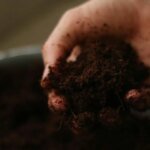
For Document’s Fall/Winter 2024–25 issue, the painter unveils a suite of large-scale paintings that fuse mysterious environments with beings alive and dead
Ambera Wellmann is no longer interested in fantasy. The painter moves through the dark to confront the terminally real in her latest suite of four paintings, conceived for the 15th Gwangju Biennale. Each canvas is nearly 8 feet tall, layered with halved fruits and severed fish heads, cast-off garments and bare flesh awash with omen. Nuclear emerald waves froth in low tide. Songbirds devour and decay. Smoke billows from a pile of corpses in blushing clouds, almost fragrant in their ascension toward a void. Throughout these pictures, nature maintains a culpable indifference, as if sated by spoils asunder in the aftermath of what is to come.
These latest works gesture to a fear that death approaches now in lapping waves, no longer waiting patiently for us on a far-off, delightful horizon. Wellmann attributes this sense of inevitability to the existential crisis of an ecology agitated past the point of no return. Mortality grazes these precarious coastlines in an entropic current, characterizing the disappearances that occur despite all efforts to the contrary. In this series, she charges her scenes with a certain simultaneity, a smudged mirror to the catastrophic conditions framing the distant present. The paintings bear their own distinct assemblages, each filled with the detritus of consumer excess, objects left behind in the fulfillment of verboten desires. The decadence of shrimp in a boiling ocean. Wellmann forebodes with patient abandon, carefully plating a feast of dismal likelihoods while innovating new ways to die.
Over Pinion, a red sun punctures a landscape comprising a familiar gutted bird. Exploded to fill the frame, the lifesize contents of the creature’s innards offer forgotten memories: bottle caps, trinkets, plastic shrapnel. Among these meticulous fragments, a golden watch keeps time, marking the survival of the objects that outlast our own decay. The gumption of the bird’s appetite. A brittle nostalgia for numbered days. The title suggests this work’s function within a larger whole, its repeated shape invoking the conventions of a mise en abyme—an image endlessly “placed in an abyss.” Rather than restraining this convention of replication to one frame, Wellmann performs a different metastatic relay in high fidelity.
In Everything Remains, a rib cage obstructs a final kiss shared by lovers on an adumbral shore. Yellowed bones puppeteer hollow bodies wrapped in the anxiety of a future too far gone. Nude figures wander stranded and supine in the blackened sands overcome with sharks and their prey. The bird appears again, a new phylum of fossil abstracted in its dereliction but rife with errant questions. Between these two works, Wellmann protracts the immediacy of a crop or zoom, affording her images proper time to reveal their convolutions. The indeterminacy of the afterlives depicted are analogous to the purgatory of process, charging these forms with a sense of agency in the time between their completion. Such experiments infer the possibility of ever-deeper incarnations waiting on the other side of revelation; they continue to bemuse the painter’s painstaking hand in the development of new work.
Wellmann’s works frequently produce each other, likely plotting when the artist is not present. She employs a process she calls catachresis, painting over previous, unfinished works. Past images manifest new life; time becomes material; realities refuse to reconcile. This patina of failure bleeds through the paintings’ layers, calling on the works to perform the process that created them. In Murmuration, the shadow of an animal’s leg lies akimbo under human bones, haunting the scene with the precise struggles of form that generate these sublime arrivals. Behind the flaming feast of bodies, the canvas appears almost charred, marked by Wellmann’s previous attempts at depicting the hungry inferno. This challenge was as much a choice as it was an impulse, symptomatic of the hard feelings at the artist’s disposal. With her search laid bare, these overwritten surfaces provide the kindling for skin ablaze with prescient dreams.
Among these wreckages, Wellmann salvages human forms with a careful attention to their surfaces. In Underwater Spring, the skin of two lovers gleams in the shadowless light of a total eclipse, foreboding a cosmic break. Wellmann’s focus on figuration foregrounds tactility in these inexplicable anatomies—bodies rendered with precision, yet contorted as if cruel experiments by the gods. A face cupped to uncertain loins divulges secrets before the rocky apex is consumed by the murk. An outstretched arm caresses the rising tides in rapture, relinquished to a sanguine tongue. The painter articulates this signature configuration with new clarity, but allows the textures of skin to eschew their own social contingencies. Bloodshot eyes emerge from the water’s surface with nowhere to hide, meeting the eyes of the viewer with daunting intrigue. This half-submerged sentinel reckons with the gaze on behalf of the artist: a confrontation with the questions that might arise from our own libidinous depths. The water’s dark surface offers no reflections, murky in absence, deeper than curiosity can venture. A bird sweeps beneath the darkened sun toward the frame’s edge, likely late to the blazing banquet awaiting its flock in Murmuration.
The pictures share naïve resonances, oblivious to each other yet echoing familiar violences. The backwash of a collective malady pools in intimate psychic spaces. Objects whisper sweet memories before it’s too late. Insensate carcasses furnish a marketplace of treasures. Wellmann reserves a certain skepticism for the function of beauty and tradition, instead deploying an affect that complicates foregone conclusions. She remains disinterested in distinguishing songbirds from birds of prey. These latest works slake a sinking feeling with gentle precision, detailing the decadences that cannot be separated from a penumbra of abyssal circumstances. The painter’s luxuriant eye communicates an urgency, excavating the collisions between calamity and pleasure for new means of survival, evidence of what survival is for. Her difficult constructions mumble a crisis with a mouthful of unspoken surrender.














